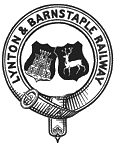
Parracombe railway station
Encyclopedia

Lynton and Barnstaple Railway
The Lynton & Barnstaple Railway opened as an independent railway in May 1898. It was a single track narrow gauge railway slightly over long running through the rugged and picturesque area bordering Exmoor in North Devon, England. Although opened after the 1896 Light Railways Act came into force,...
, a narrow gauge line that ran through Exmoor
Exmoor
Exmoor is an area of hilly open moorland in west Somerset and north Devon in South West England, named after the main river that flows out of the district, the River Exe. The moor has given its name to a National Park, which includes the Brendon Hills, the East Lyn Valley, the Vale of Porlock and ...
from Barnstaple
Barnstaple
Barnstaple is a town and civil parish in the local government district of North Devon in the county of Devon, England, UK. It lies west southwest of Bristol, north of Plymouth and northwest of the county town of Exeter. The old spelling Barnstable is now obsolete.It is the main town of the...
to Lynton
Lynton
Lynton is a small town in Devon, England. It lies on the northern edge of Exmoor and is located at the top of a gorge above Lynmouth, to which it is connected by the Lynton and Lynmouth Cliff Railway...
and Lynmouth
Lynmouth
Lynmouth is a village in Devon, England, on the north edge of Exmoor.The village straddles the confluence of the West Lyn and East Lyn rivers, in a gorge below Lynton, to which it is connected by the Lynton and Lynmouth Cliff Railway....
in North Devon
Devon
Devon is a large county in southwestern England. The county is sometimes referred to as Devonshire, although the term is rarely used inside the county itself as the county has never been officially "shired", it often indicates a traditional or historical context.The county shares borders with...
. The Halt which served the village of Parracombe
Parracombe
Parracombe is a rural settlement near Lynton, in Devon, England. It is situated in the Heddon Valley, on Exmoor.A number Bronze Age barrows exist nearby, along with several other small earth-works throughout the parish. Beacon Castle and Voley Castle both Iron Age Hill forts are situated nearby...
comprised a simple wooden shelter and was not opened until May 1 — almost a year after the line was opened on 16 May 1898 — and closed along with the rest of the railway on 29 September 1935. It is planned this station will be reopened next by the Lynton & Barnstaple Trust.
History
The village of Parracombe was the second largest intermediate settlement along the route of the railway, however its population was less than 400 souls. There was local opposition to the line by one landowner, Mr. Charles Blackmore, of Court Place. However, he was the only detractor. His younger brother Mr Henry Blackmore, the proprietor of the Fox and Goose Hotel was actively supportive. The railway company was so short of money that no station was built here, despite meetings to decide a location for a proposed station. When the Halt opened it appeared in timetables as Parracombe Churchtown. Tickets were dispensed by the local Post Office. Even though it was a halt most trains stopped at Parracombe as there was a good water supply at the station, and the water supply often failed at Lynton and LynmouthLynton and Lynmouth railway station
Lynton and Lynmouth was the terminus of the Lynton and Barnstaple Railway, a narrow gauge line that ran through Exmoor from Barnstaple to Lynton and Lynmouth in North Devon. The station served the twin towns of Lynton and Lynmouth . It opened with the line on 7 March 1898, and closed with it after...
due to the height of the latter station.
From 1923 until closure, the line was operated by the Southern Railway
Southern Railway (Great Britain)
The Southern Railway was a British railway company established in the 1923 Grouping. It linked London with the Channel ports, South West England, South coast resorts and Kent...
.
The Southern Railway replacement concrete shelter is still evident, although a bungalow and other buildings obscure part of the formation, and infilling of part of the cutting has buried the trackbed since the site was auctioned, along with the rest of the trackbed, in 1938.

